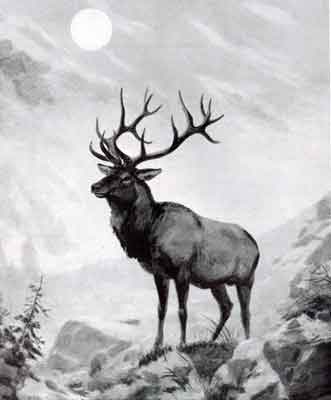Our Noblest Deer, The American Elk or Wapiti
By VERNON BAILEY
Nature Magazine, September 1937
Page 1 | Page 2 | Page 3 | Page 4
Far famed in poetry, art and royal sport, the Old World stag is a splendid deer, well worthy of a Walter Scott or an Edwin Landseer. It is generically related to our American elk or wapiti, but is considerably smaller, with lighter antlers. Next to the moose our elk is the largest living deer in the whole world, and the adult bull in full prime with towering rack of antlers is truly a magnificent animal.
Only two centuries ago these great deer roamed in millions over prairies and plains, through the forests and over the mountains from the Atlantic to the Pacific, and from Canada almost if not quite to Mexico. Their numbers are now reduced to a few thousands in restricted areas of the far west. Their rapid reduction was inevitable for several reasons. They were needed to feed and clothe the explorers and pioneers who swept across the continent ahead of permanent settlements; they had little regard for fences and were fond of most of the crops raised by the farmer for his own use. They ate the grass needed for his cattle, horses and sheep, and would have eaten the haystacks left out over winter, had they not been nearly extirpated for meat before the rancher, with his cattle and crops, reached their range.
But for the beaver, the buffalo, the deer, and the elk our country would have been explored and settled much more slowly, and the United States might still have remained the original thirteen colonies, even if these had dared to cut loose from old ties. The debt we owe to the rich resources of the New World has never been fully appreciated nor has our use of the wealth here stored for ages been always wise. Much of it has been wasted or wantonly exploited for personal gain. Thousands of elk have been killed for their hides or merely for the two upper canine teeth to be sold as trinkets. Only in recent years have we as a nation begun to realize our responsibility in the conservation of native wild life, which is not, as it first seemed, inexhaustible. Now we must act quickly or it will be too late.

ANTLERED MONARCH OF THE WASTE
What a surprise it was to the early explorers to find in the forests of the New World "deer as big as horses" or "bigger than oxen", great herds of them, not so wild or timid as the small Virginia deer, easier to kill and better to eat. Some of the earliest records of elk were made in 1535, from eastern Canada near the present site of Montreal; from Virginia in 1650; from Carolina in 1731; from Pennsylvania in 1748. But their great numbers did not last long. As early as 1784 Pennant wrote that "elk are decreasing as population gains ground in the Colonies."
There were still a few elk in New York State in 1842, and in Pennsylvania the last one was killed in 1867. They were reported in West Virginia as late as 1847, but at that time they had disappeared from Kentucky. At that time it was said some still remained in Illinois, but no abundance of them short of far up the Missouri River.
My father killed his first and only elk in Tuscola County in southeastern Michigan in 1857, but when my people moved from Michigan to Minnesota in 1869 the elk had nearly disappeared from both states. We settled at Elk River, Minnesota, but then only a few old antlers were found in the woods where elk had been numerous a few years before.
In 1800 elk were abundant in the Dakotas (Dakota Territory), but as these rich prairie states filled up with settlers during the next eighty years, the elk were killed off ahead of the settlements. Lewis and Clark, when wintering among the Mandan Indians on the Upper Missouri in 1804 and 1805, found elk meat a staple food of the natives for much of the winter, and Maximilian in 1833 and Audubon in 1843 found elk still plentiful in that general region. Roosevelt reported them abundant along the Little Missouri River up to 1881 "when the last of the big herds was slaughtered".
 Printer-friendly version
Printer-friendly version
